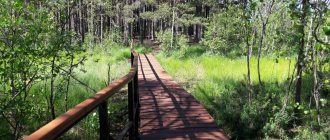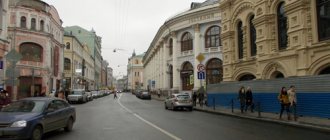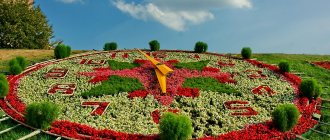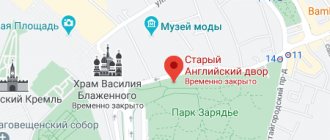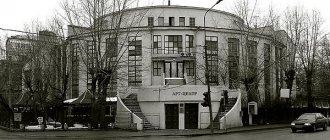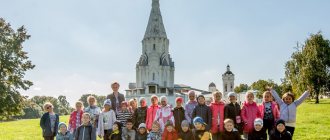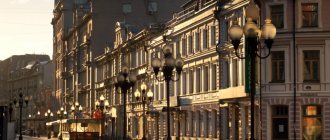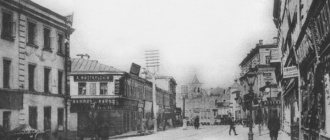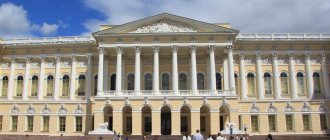By visiting the courtyard, called Krutitsky, you can touch the pages of the history of the relationship between Rus' and the Golden Horde and the rise to the throne of the Romanov dynasty.
Brick towers and churches in Zamoskvorechye, surrounded by greenery, invite you to plunge into a unique and protected corner of ancient Moscow, combining stone architecture with ancient wooden houses. Now the Synodal Department of the Russian Orthodox Church for work with youth operates here, but the courtyard still remains one of the favorite places for Muscovites to walk.
Origin of the name and its meaning
The Krutitsa courtyard first appears in written sources in the 13th century; history attributes its creation to Prince Daniil of Moscow. The future residence of the bishops of Sarai received its name from the area where it is located.
As the chronicles say, the hills on the left bank of the Moscow River, from the mouth of the Yauza to Simonovo, were called Krutitsy, from the word “steep”, a high and reciprocal bank, as opposed to the right, flat bank, where they usually began to build a city.
The term “monastery” indicates that the complex included not only religious buildings, clergy houses and fraternal buildings, but also buildings for domestic purposes and agricultural land.
The Krutitsa metropolitans had great influence in the 17th century, and many villages developed under their care, including only in the territory of modern Moscow these were Dubrovka, the Arbatets settlement, the modern Krutitskaya settlement and the former village of Kozhukhovo, located on the site of the modern Kozhukhovskaya metro station.
What to see in the Krutitsky Compound?
Here are the main interesting objects at the Krutitsky Compound:
- Assumption Cathedral. Construction was completed in 1700. Services are regularly held in the temple, and a church shop is opened in the neighboring house.
- Metropolitan Chambers (Palace of Krutitsa Metropolitans) - built 1655-1670.
- Church of the Resurrection of the Word on Krutitsy (17th century).
- Krutitsky Teremok above the Holy Gates - 1693.
- Embankment Chambers (summer house of the metropolitans) – 1719.
what to see in the Krutitsky courtyard
But the main charm of Krutitsy is not in the famous temples and palaces, but in the small wooden houses of unknown purpose, in the ancient stone steps overgrown with moss, in the closed doors leading incomprehensibly to where with heavy locks, in the servants and workers hurrying about their business, who are here clearly more than tourists. It smells like a dacha, the Moscow region, to which this area belonged in the past centuries. The dew on the grass does not dry for a long time, and the burdocks have grown almost to human height. There is also a small cherry orchard here, which you should definitely visit in the spring.
History of the Krutitskoye Compound temple
The construction of the Krutitsa courtyard began in 1272, when the young Prince Daniel built a temple here in the name of the apostles Peter and Paul, and a small monastery soon arose under it. Daniil Alexandrovich, the 4th son of Alexander Nevsky, who lost his father at the age of 2 years, was subsequently recognized as faithful. In the year of the founding of the temple and monastery, he received Moscow as his inheritance.
By that time, the young prince was only 12 years old. Daniel's son was Ivan Kalita, collector of Moscow lands. At first, the prince wanted to build his own mansion in Krutitsy, but an unknown hermit, who was called the Roman, who settled on the future holy place, advised against it, saying that a temple and a bishop’s house would be erected here.
After the construction of the temple here in 1300, the Greek bishop Varlaam, who became the first bishop, found his home.
A little later, from 1450, the courtyard became the official Moscow residence of the bishops of Saraisky, and then of Krutitsky. The diocese was located in those distant times in Sarai, the capital of the Golden Horde, and took care of the Christians living there.
The first, recognized by historians as beyond doubt, mention of the metochion in documents as a monastery, and not as a temple, appeared in the will (spiritual charter) of Prince Ivan the Red, signed in 1358. Interestingly, the format of the grant suggests that in those days the metochion was already a monastery, and not just a temple. The contribution was intended for prayer for the prince and his relatives.
Dmitry Donskoy made a similar testamentary refusal in favor of Krutitsa. During the Time of Troubles, the history of the Compound is associated with Minin and Pozharsky; at one time the Assumption Cathedral was the main temple of Russian Orthodoxy. The heyday of the metochion occurred in the second half of the 17th century, when it was ruled by Metropolitan Paul III.
An outstanding figure of the pre-Petrine era, an educated and cultured clergyman, did a lot to create the modern architectural appearance of the ensemble; under him, transitions from the Assumption Church to the Metropolitan's palace and towers were erected. The Metropolitan created his own mini-paradise here, where the luxurious park was decorated with “water cannons” (fountains) fed by water from springs.
During this period, the bishop supervised the correct translation of the Bible into the Old Church Slavonic language, and it was here that the translators worked. During the War of 1812, all buildings were almost completely burned out. Restoration began in 1838, when the heir to the throne, who would ascend the throne under the name Emperor Alexander II, paid a visit here.
After the revolution, barracks were located here, then the VOOIK society. The transfer of the buildings of the church courtyard began in 1991, at which time the courtyard officially received the status of Patriarchal.
Thus, the history of the farmstead can be divided into the following stages:
- early, from 1272;
- official residence of the bishops of Sarah, from 1450;
- abolition of the residence, from 1785;
- Soviet, since 1920;
- modern, since 1991.
History of creation
According to legend, the emergence of a monastery in the princely village of Krutitsy on the left bank of the Moscow River was predicted by a local hermit to Prince Daniil of Moscow.
The prophecy came true in 1272, when the construction of the wooden church of the Holy Apostles Peter and Paul and the monastery attached to it was completed. The village of Krutitsy, and then the local monastery, got their name because of the coastal hills that stretched from the Yauza to the Simonovo tract and made the river bank so steep. The Krutitsky monastery, under Prince Daniil Alexandrovich, entered the Sarai diocese and, by the prince’s will, became the metochion of the Sarai bishops. Their main residence was in Sarai, the capital of the Golden Horde, and the Sarai diocese itself was established in 1261 by Metropolitan Kirill III of Kyiv. The bishops, in addition to caring for Russian prisoners and converting the Tatars to Orthodoxy with the permission of the khan, carried out a serious diplomatic mission and were a link between Russia and the Horde. The bishops stayed in Krutitsy during their visits to the All-Russian metropolitans and the great Moscow princes, until they moved to the courtyard for good. This happened in the second half of the 14th century. In the wake of changes, the Sarai diocese was renamed Sarsk and Podonsk, and the former Sarai bishops became Sarsk. From that moment, according to the decision of the Moscow Council, the Sarsk and Podonsk bishops became the closest assistants to the All-Russian metropolitans. The Council of 1581 decided that Bishop Gelasius of Sarsk and Podonsk should be metropolitan. Having assumed new powers, in 1591, Metropolitan Gelasius took part in the trial of the murder of Tsarevich Dimitri; It was Gelasius who performed the funeral service for the heir to the throne.
After the death of the young son of Ivan the Terrible, the unrest grew and penetrated into the very heart of Moscow. At this time, at the beginning of the 17th century, the Krutitsky courtyard had to play the role of the cathedral of Russia.
In 1611–1612, people's militias moved past Krutitsy, conveniently located near both land and waterways, towards the Kremlin occupied by the Poles. In the stone Assumption Cathedral of the courtyard, and not in the main Assumption Cathedral of the Moscow Kremlin, the soldiers swore with a kiss on the cross that they would save Rus' or lay down their heads. The history of the schismatic Old Believers did not pass by the Krutitsky courtyard either. Metropolitan Paul II (1664–1676), also known as the founder of the rich library of the metochion, put a lot of effort into subduing the famous schism teachers, among whom were Archpriest Avvakum and Deacon Theodore.
The current status of the Krutitskoye Compound temple
The complex is a large museum and religious center, having the status of a Patriarchal metochion. Now the Synodal Department of the Russian Orthodox Church for Youth Affairs operates here, which is headed by Archpriest Kirill Sladkov, who is also the rector of the Assumption Cathedral. It is operational and services are regularly held here.
The historical and architectural complex is in need of restoration; the Synodal Department is actively engaged in this work, attracting the help of philanthropists and volunteers from among Orthodox youth.
Krutitsky courtyard today
In a sense, Krutitsy can be called an open-air museum. Except for the Assumption Cathedral, all buildings are now closed to the public and can only be admired from the outside. But you won’t spend any money - except perhaps on pies in the stall at the entrance or on candles in the temple. Unlike the well-groomed museum grounds, here you can and should climb everywhere, go through dilapidated gates, walk on the grass, look into the windows of service premises, take photographs of everything and everywhere. We only advise you to wear comfortable shoes, because there is no asphalt in this historical corner - only uncomfortable cobblestones, dirt and tall grass.
Architecture of the Krutitskoe Compound temple
The center of the architectural composition was the ancient Church of the Dormition of the Mother of God. Its construction was completed in 1700. At the time when the Archbishop of Sarai, Vassian, first entered the current territory of the courtyard in 1454, there was already a temple in the name of the apostles Peter and Paul, and it was not wooden, like many churches in Moscow, but stone.
It was on its basis that Uspensky was created. Since the Assumption Cathedral, built by Aristotle Fioravanti, was in operation in the Kremlin, the new temple began to be called the Krutitsky Small Assumption Cathedral. It took its place in Russian history in 1612, when the Kremlin was occupied by the Poles, and it was this cathedral that was entrusted with the responsibility of becoming the main cathedral church of Moscow Orthodoxy.
Later, in 1665, construction began on a new temple, which had 2 side-chapels. The lower one, for winter services, was erected in the name of the apostles Peter and Paul, the summer one - in the name of the Dormition of the Virgin Mary.
The architecture of the original building was simple; only one dome rose on four tables; there was a small basement and a vestibule with a three-part apse. The new one was built close to the canons of the Moscow and Naryshkin baroque. Above it, 5 domes soared into the sky; the four-slope roof was decorated with a tier of kokoshniks.
The ensemble is complemented by a hipped bell tower and a western vestibule. 5 chapters are typical for Russian Orthodox architecture; they symbolize Jesus Christ surrounded by 4 apostles. What makes the building unusual is that the bell tower is built on the south side; this is uncharacteristic of the Moscow style. Covered galleries stretch towards the palace of the governors.
Krutitskoye Podvorye - plan of the complex on the map.
All structural elements, including the domes of the cathedral, are made of red brick. This material has become the hallmark of the farmstead; all its buildings are made from it. The main architect of the church, responsible for its construction, was Osip Startsev, who combined the traditions of Old Russian architecture with lush decorative design. He also worked on the ensemble of the Novodevichy Convent.
The main stage of construction was completed in 1689, and it took another 11 years for the upper aisle to begin working. In 1895, another chapel was added to the temple, in the name of Sergius of Radonezh. The temple housed the tomb of the metropolitans, the walls of the cathedral were decorated with paintings. In 1920, it was completely destroyed; the Bolsheviks destroyed the sarcophagi and painted over the paintings.
Services resumed in 1990, and restoration of the building and icons is still ongoing. In addition to the main temple, there are several other buildings on the territory of the complex that have religious, historical and architectural significance. The table shows the years of construction and the styles in which they were built.
| Construction | Year of construction | Architectural style and features |
| Assumption Church | 1700 | Moscow Baroque |
| Metropolitan Chambers | 1664-1665 | |
| Resurrection Church | 1516 | Staromoskovsky. The basement with burials and basement have been preserved. |
| Holy Gates and Krutitsky Teremok | 1693-1694 | Staromoskovsky. Tiles used |
| Transitions from the Assumption Cathedral to the Chambers | 1693-94 | Staromoskovsky |
The Temple of the Hieromartyr Clement, Pope of Rome, attracts interest. Buildings that do not have a direct religious purpose are also interesting. The residence of the Metropolitan is near the Metropolitan Chamber, a palace distinguished by its expressive Old Moscow architecture. The adjacent basement of the cathedral was rebuilt into the reception room of the rulers, the Chamber of the Cross.
Later it was rebuilt again and became the Church of the Resurrection of the Word.
The attention of visitors is attracted by the tower, decorated with miraculously preserved tiles, of which there are up to 2,000 pieces. It was built during the time of Archbishop of Sarsk and Podonsk Paul I.
The Teremok is part of the front gate ensemble. A walk along the cobblestone main square will make you remember the centuries when life was bustling here. You can also explore the ancient wooden residential buildings of the neighboring streets, which were historically part of the courtyard.
Don’t miss the most popular article in the section: Optina Pustyn Monastery - how to get there from Moscow, address, where it is located, history and interesting facts.
A little history
The history of the farmstead began from the time of the Tatar-Mongol yoke, i.e. from the 13th century. This area was provided to the Sarsky bishops so that they could stop and rest on the way to Moscow. It is not known exactly who founded the monastery here, but the courtyard gradually grew, and a high stone wall with four towers appeared. The shrine was protected from destruction and plunder by the khan’s safe conduct.
Over time, the monastery began to play a fairly serious role. The route to the cities of those times where trade was carried out passed through it, and later the diocese was moved here. The courtyard turned into a bishop's residence.
During the Time of Troubles, many city churches in the city were captured by Polish soldiers, but local residents had the opportunity to attend services in the courtyard. In 1612, the militia of Minin and Pozharsky in Krutitsy took an oath to liberate the capital from its enemies. At that time, the cathedral was considered the main thing for local residents.
At the end of the 17th century, reconstruction took place, and the buildings received their current appearance. The cathedral was rebuilt, a gatehouse and passages from the cathedral to the Metropolitan Chambers appeared. But in 1764, the Podonsk and Sarsk diocese ceased to exist, and a little later, the Krutitsa diocese. Church values moved to the Kremlin, to the Chudov Monastery, after which the Assumption Cathedral became a modest parish-type church for the military. They built a guardhouse and barracks buildings, but did not touch the previous buildings.
Important! Church chronicles of the metochion were interrupted in 1798.
After the fire of 1812, nothing remained of the temple, but over time the church insisted on restoration. Since 1924, the military was again stationed in this territory. They say that the arrested Lavrentiy Beria was kept in local barracks.
After the war, the cultural monument was reconstructed and given museum status. At first, the courtyard existed as a branch of the Historical Museum, and then some of the objects were transferred to the Russian Orthodox Church.
Interior decoration of the Krutitskoe Compound temple
The famous tile master Stepan Polubes was responsible for the interiors of the Assumption Church. He founded his workshop in Goncharnaya Sloboda and after decorating the cathedral in the courtyard, he was noticed by the Tsar. To get to the upper, Assumption Church, you need to overcome several steps of the Northern Porch. The inside of the temple is very spacious, this effect was achieved due to the absence of tables.
The Bolsheviks were unable to destroy part of the dome painting; it was preserved in its original form. The wall paintings were renewed at the end of the 10s of our century. The iconostasis is modern, made in the traditions of the 17th century. The tiled flooring is modern and very simple. The lower aisle was transferred to the church before the upper one. In 1993-95, restorers actively worked here.
They removed the paint from the walls and revealed part of the paintings dating back to the 19th century. The iconostasis is also modern, it would have been made by the Vyatka artel of craftsmen. The icons for it were partly painted anew, partly purchased from antique dealers with funds from donors.
In recent years, Igor Myasnikov, a member of the Academy of Painting, Sculpture and Architecture, was responsible for the restoration of the temple, who made efforts to restore the interior and paintings.
Shrines of the Krutitskoye Compound temple
The Krutitsy courtyard and its Assumption Cathedral attract parishioners not only with its old Moscow architecture, but also with its shrines. Many icons are in need of restoration, some have already found their benefactors, among them is a list of the miraculous Theodore Icon of the Mother of God from the 18th century.
Emergency conservation was carried out and restoration began on the icons “Do not weep for Me, Mother” (XVIII century) and the Mother of God “Quench My Sorrows” (XIX century). The copy of the Feodorovskaya icon became the most revered shrine of the temple. The icon itself is located in Kostroma, in the Bogovlensko-Anastasia Monastery. Tradition attributes its authorship to the brush of the Apostle Luke; the iconography resembles that of Vladimir, revered in Russia.
It was lost and reappeared; some historians consider it a gift for the wedding of Prince Alexander Nevsky, commissioned by his father. Theodore Stratilates, after whom it is named, was the heavenly patron of Prince Yaroslav.
Subsequently, the image was associated with the imperial house of the Romanovs; Tsar Mikhail Fedorovich was blessed by her mother, the nun Martha, for the kingdom. In the name of this image, German princesses-wives of Russian emperors received the patronymic name Fedorovna after marriage. In addition to ancient icons, believers are attracted by the ark with the relics of many saints.
Krutitsky Compound in cinema
The undaunted antiquity and lush greenery of Krutitsa have been attracting directors since the late 70s. Two films each about Boris Godunov and Ivan the Terrible, separate episodes of the films “Young Russia” (1981), “Burn, Burn, My Star” (1969), “Mikhailo Lomonosov” (1986), “Midshipmen, Forward!” were shot here. (1987), “Ermak” (1996), “The Brothers Karamazov” (2009). The Krutitsy Compound managed to “visit” the Kremlin, the Uglich Palace, the Old Believer temple where Savva Morozov prayed, the cities of Kiev, Chisinau, Revel (the old name of Tallinn) and just a conventional Russian monastery.
Mostly, of course, films and TV series about Russian history were shot here. But this list somehow included “Brother-2” (one of the Krutitsa houses plays the role of the Matveevsky police department), “Daun Haus”, the serial melodrama “Give Me Resurrection” (2012), and the comedy “Scammers” (1990). Polish director Krzysztof Zanussi also visited the courtyard.
Interesting facts and legends
One of the widespread legends associated with the place is that the first residence of the Sarai bishops was founded here during the reign of Prince Daniil of Moscow, and they stayed here when visiting Moscow. This is unlikely, since during the time of the son of Alexander Nevsky, the future capital was still a small town on the outskirts of the Vladimir-Suzdal land.
The city became the religious center of Rus' only during the reign of Ivan Kalita, when the see of Metropolitan Peter was moved here in 1327.
There are legends associated with specific buildings. Not everyone knows that in one of the corner towers, which is located next to the Assumption Cathedral, there is a chapel. From the windows of the patterned tower, according to legend, the metropolitans of Sarai and Podonsk blessed the townspeople who were getting ready for the holidays. The compound is known for its famous prisoners.
During the period of the schism, it was here that Archpriest Avvakum languished, waiting for the council of 1666 to condemn him to damnation. During the time of Nicholas I, the writer and journalist I.I. Herzen spent some time here. On one of the buildings of the Chambers of Orders you can see a memorial plaque informing about this fact.
The official website of the Compound reports that L. Beria was also its prisoner at one time, and perhaps it was here that he was secretly shot. After the Compound was transferred to the church and its restoration began, 98 trucks filled with garbage were removed from here.
Architectural ensemble
The main attraction of the courtyard is the Small Assumption Cathedral , built in 1667-1689. It can be entered via a tall staircase, and although the door is closed, the staircase makes a good place to take photos. In 1950–80 the courtyard was reconstructed, and now you can see it as it was in ancient times.
On the right side of the entrance to the Peter and Paul Lower Church of the Cathedral, a six-span hipped bell tower adjoins the temple. Even at the end of the 19th century, there were powerful bells here, one of which, a small one, was cast in 1730.
On the territory of the courtyard there is a small cherry orchard . It is in excellent condition. It can be seen that the trees are looked after, the trunks are carefully whitened and the dried branches are cut off. In spring, during cherry blossoms, there are especially many tourists here.
Archpriest Avakuum was imprisoned in Krutitsy before his curse in 1666. During the Soviet era, military barracks were located here; there is a controversial opinion that L.P. Beria was kept in Krutitsy.
The first church of the monastery - Peter and Paul , built in 1272 as the main church of the monastery, was consecrated in the name of the apostles Peter and Paul. Subsequently, the lower temple of the main Assumption Cathedral (see above) was also consecrated in honor of the chief apostles.
The Church in honor of the Resurrection of the Word, that is, the Resurrection Church now consists of a basement with the burials of the Krutitsa metropolitans, a basement and an upper tier, dating back to the mid-18th century. The northern aisle in the name of St. Nicholas was built in 1516 and is now not consecrated; it is used for economic purposes.
The Krutitsa rulers were buried in the crypts under the chapel of St. Nicholas: “on the right side of the east” - Bishop. Euthymius (+ 1499), “on the right side of the west” - bishop. Simeon (+ 1582), “on the left side of the east” - bishop. Dositheus (+ 1544). Here are the graves of Metropolitan. Gelasia (+ 1602), bishop. Hilarion (+ 1760) and a certain Theodore.
In 1693–1694, the Krutitsky tower and covered passages leading from the metropolitan chambers to the main Assumption Cathedral were built. According to legend, from the windows of this tower the Krutitsa bishops blessed the people gathered in the square, admired the view of Moscow, and also distributed alms to the poor.
The Teremok and the Holy Gate are lined on the outside with multi-colored glazed tiles. During the construction of the tower, approximately 1,500–2,000 tiles were used, the manufacturer of which was presumably the master Stepan Ivanov.
The Holy Gate was decorated with fresco images of the Dormition of the Blessed Virgin Mary, the Savior and some saints. Construction work was carried out under the supervision of the outstanding Russian architect of the 17th century Osip Startsev and stone mason Larion Kovalev.
During the fire of 1737, the tower was badly damaged, after which its tiled roof was replaced with an iron one, the damaged faces of the saints were whitewashed with lime, and one of the passages in the holy gates was blocked. It remained in this form until restoration in 1868, when they tried to give it its original appearance.
The Palace of Krutitsa Metropolitans - a two-story brick building measuring 27.25 x 12.35 m - was built in 1655. The thickness of the walls on the first floor reaches 120 cm, on the second floor - up to 115 cm. An elegant porch, restored in the 20th century, adjoins the southern facade of the building.
On the ground floor there were obviously utility and other service premises, on the second floor there were ceremonial and residential premises. On May 15, 2010, the transfer of the Metropolitan Chamber to the Church took place. In this regard, the chamber is being restored with funds from the Ministry of Culture.
In 1719, the Krutitsky ensemble was supplemented with embankment chambers.
Lovers of antiquity will definitely like it here. The walls of the buildings, untouched by the hand of a modern plasterer, immerse you in the atmosphere of the 16th century. It just seems like a carriage, like the ones in the Armory, is about to appear around the bend, and people in ancient clothes will get out.
Now the Krutitsky courtyard is a branch of the Historical Museum, and the tower above the Holy Gate is under the protection of UNESCO.
Address, how to get to the temple
The Krutitskoye Compound is located in Zamoskvorechye, the nearest metro station is Taganskaya. The architectural complex can be reached by crossing to the left bank of the Moscow River along the Novospassky Bridge. Official address: Krutitskaya street, 13/1. You can also go from the Proletarskaya metro station.
The signs should find the exit to the 3rd Krutitsky Lane, go up, turn left onto Novospassky Passage, and then right into the 1st Krutitsky Lane. From here you will already be able to see the domes of the Assumption Cathedral.
How and when the farmstead was created - an excursion into history
So, we have examined the main elements of the entire architectural ensemble. Now it’s worth telling in more detail about how and at what time the Krutitsky courtyard appeared in Moscow. Its history is extremely interesting and full of various surprises. To begin with, it is worth noting that the village of Krutitsy itself was located in a very advantageous location. It was here that important routes passed, which have long been actively used for trade and other purposes. These routes led to Ryazan and Kolomna.
There are several versions of how the courtyard appeared. According to the first, a temple was founded on this site back in the 13th century. This happened under the leadership of Prince Daniil of Moscow. There is another legend that says that a Greek chronicler named Varlaam originally stayed here. He settled in these places, and a church was founded here, and subsequently a monastery arose around it.
Schedule of services
The Assumption Cathedral convenes parishioners for divine services on Sundays and on great church holidays. Traditionally, the day before, at 17:00, Orthodox Christians come to the All-Night Vigil; the morning liturgy begins at 9:00. On Saturdays, parishioners can come to matins and liturgy at 8-00.
Additionally, throughout Lent, two Liturgies of the Presanctified Gifts are held every week. The time of the event must be confirmed, it starts at 8-00. Every Thursday an akathist is read in front of the Theodore Icon.
Patronal holidays are:
- Dormition of the Blessed Virgin Mary;
- Sunday of the Word.
What objects does the courtyard include?
Thus, we got to know this place a little and reviewed general information about it. Now it’s worth talking a little about what you can see when visiting the Krutitskoye Metochion in Moscow. There are several objects located here, each of which is of separate interest. All these objects are cultural monuments and keep their own history. So, the courtyard includes:
- Cathedral of the Assumption of the Blessed Virgin Mary on Krutitsy (built in 1700).
- Krutitsky tower and Resurrection passages (created in the 17th century).
- Metropolitan Chambers (built at the end of the 17th century).
- Church of the Resurrection of the Word on Krutitsy (erected in the 17th century).
- Corps of Metropolitan Orders and other objects.
Now it has become clear what the courtyard includes, as well as what it is known for. Almost all the buildings located here date back to the 17th century. Watching them and learning their history will be very educational for every person who comes here. Now it’s worth talking in more detail about some of the objects that are of the greatest interest.
Excursions
It is possible to book a tour of the former Krutitsky Monastery, during which a professional guide will tell you about the secrets and legends of the ancient compound. Please note that at the entrance to the complex there is a sign prohibiting photography. Excursions can be either paid or free.
The route “Masterpieces of the Krutitsky Metochion and the Novospassky Monastery” is popular in Moscow; it combines two historical ensembles. You can order it from the tour operator “Travel Store” on the website masput.ru. Its cost will be 2600 rubles. for a group of 1-8 people.
Will be visited:
- Compound;
- the oldest surviving monastery in Moscow, Novosspasky Monastery;
- The main pumping station, a masterpiece of industrial architecture.
The same operator offers an author’s tour “Tiled Moscow”, conducted by historian and local historian Valery Strakhov. It is carried out only on the territory of the complex, the cost is 500 rubles. per person. The walking route “Walk around the Krutitsky Compound”, lasting 1.5 hours, can be easily found on the website silver-compass.ru, from the tour operator “Silver Compass”. The ticket price will be 350 rubles.
During the excursion you can get to one of the concerts, which is held in the Temple of the Hieromartyr Clement of the Pope. Both the Patriarch's own choir and invited performers can perform. By visiting the farmstead, you can take part in its restoration; a group of volunteers is now working here.
For young people visiting the courtyard, the Synodal Department organizes Krutets quests, by participating in them you can touch the secrets of the history of the place, the traditions of religious holidays, and the history of icon painting. In the near future, it is planned to create a single museum and cultural space “Museum on Krutitsy”; funds for the project are expected to be collected on crowdfunding platforms.
A trip to Krutitskoye will be interesting both for those who are interested in the history of Moscow, and for Orthodox people, for whom the opportunity to touch the shrines of the courtyard will be a good opportunity to feel the spirit of ancient Orthodoxy.
Author: Tatyana Shokhina
Article design: Oleg Lozinsky
